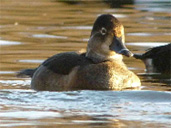Homecoming of sorts for rare duck at WWT Slimbridge

A RARE duck has arrived at WWT Slimbridge Wetland Centre just over half a century after its species was first discovered here by the late Lady Scott.
The first ever recording of a ring necked duck in Europe was made in 1955 by Lady Scott, who passed away in January.
Since then there has been a further three arrive at the wetland centre in Gloucestershire, including the female which was found on the South Lake on Sunday evening.
The duck is common in North America where it breeds and then each winter it migrates south sometimes as far as Central and South America.
But this one is believed to have lost its way in the strong south westerly winds seen in November.
As well as the link to the wife of the founder of the Wildfowl & Wetlands Trust Sir Peter Scott, the duck is also significant because it was the first species to conclusively demonstrate that birds did journey across the Atlantic.
Sceptics who disbelieved birds could fly such long distances were silenced when a ring necked duck which was ringed at Slimbridge in 1977 was later recovered in Greenland.
Martin McGill, senior reserve warden at WWT Slimbridge, said: “It is always exciting to see a rare visitor such as this one at Slimbridge and this time it has added significance for us here because of the link with Lady Scott.
“She made a remarkable discovery in 1955 – not many people can say they have discovered a first wildlife sighting for Europe.
“I identified it late on Sunday evening which will frustrate many keen birdwatchers who because of work commitments may not be free to visit until next weekend.
“It is in good health and could well stay for a while. The name can seem a little misleading as only the males have a ring around their necks and even this is only seen during their mating displays.”
Explore Gloucestershire
2 February 2010
For further information.
OTHER NEWS
